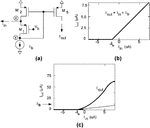mirror_pole
Member level 3
Guys i would really like to understand how the flipped voltage follower current sensor works, because i just dont get it from reading this papers.
From my understanding and calculation M1 and M2 form a transimpedance amplifier with shunt feedback, which makes the input resistance at node x very low.
From Paper:
"Due to the shunt feedback provided
by transistor M2, the impedance at node X is very low
and, this way, the amount of current that flows through this node
does not modify the value of its voltage. Note that node X can
source large current variations at the input and the FVF translates
them into compressed voltage variations at output node"
-> What benefit do i get that the current through node x doesnt change the voltage because of the low impedance? What exactly does "node x can source large current variations" mean?
"Because of the feedback loop, the actual amplifier only has
to process the error signal, which is very small. That means that M2 must draw virtually the
entire input current Iin".
->can somebody pls explain this to me. Why is the error signal very small and why does M2 draw virtually the entire current?
Best regards
From my understanding and calculation M1 and M2 form a transimpedance amplifier with shunt feedback, which makes the input resistance at node x very low.
From Paper:
"Due to the shunt feedback provided
by transistor M2, the impedance at node X is very low
and, this way, the amount of current that flows through this node
does not modify the value of its voltage. Note that node X can
source large current variations at the input and the FVF translates
them into compressed voltage variations at output node"
-> What benefit do i get that the current through node x doesnt change the voltage because of the low impedance? What exactly does "node x can source large current variations" mean?
"Because of the feedback loop, the actual amplifier only has
to process the error signal, which is very small. That means that M2 must draw virtually the
entire input current Iin".
->can somebody pls explain this to me. Why is the error signal very small and why does M2 draw virtually the entire current?
Best regards
